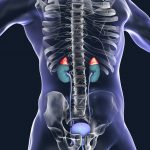GI Distress in a Young Male: An Elegant Naturopathic Approach to a Complex Disorder
Student Scholarship – First Place Case Study
Roxanne Ahmadpour
Jennifer Brusewitz, ND
Functional gastrointestinal (GI) disorders are physical manifestations that arise in the absence of structural or biochemical abnormalities. These are typically disorders of gut-brain interaction and can include visceral hypersensitivity; abnormalities in gut motility, immune and mucosal function; intestinal microbial imbalances; and distortions in CNS processing.1 Functional disorders are the most common GI conditions in the general population, accounting for roughly 40% of GI complaints seen by doctors and therapists in the United States.2 This case describes a foundational naturopathic approach to a patient presenting with myriad symptoms of severe digestive disturbance without a discernible diagnosis.
Presenting Concerns
A 21-year-old male presented to our clinic with a 5-month history of persistent nausea, vomiting, abdominal pain, and bloody diarrhea of unknown cause. These symptoms resulted in a 114 lb weight loss over this 5-month period (starting weight 275 lb, down to 161 lb at our first office visit). He reported that his current symptoms began after eating out one day, and that he was the only individual in his party who experienced any symptoms after the meal. His abdominal distress continued to worsen, and after 4 months of visits to his primary care physician, the emergency department, and several gastroenterologists, as well as thorough diagnostic workups, there was no definitive diagnosis.
Since eating would reportedly trigger nausea, vomiting, and cramping abdominal pain, he began to eliminate foods from his diet. At the time of presentation to our clinic, he was subsisting on 4-5 slices of white bread daily – the only food he could tolerate without vomiting. He described his abdominal pain as constant, extreme and localized to the right-lower quadrant, initially exacerbated – and then relieved – by bowel movements (BMs). He reported an average of 5-6 BMs per day, Bristol type 5 to 7, consisting of a large quantity of watery and occasionally bloody stool. He reported his nausea was constant throughout the day, with vomiting occurring about once per week. The patient reported significant distress, including feelings of anxiety and depression due to the severity of his symptoms, his rapid weight loss and decline in functioning, and no conclusive diagnosis or treatment.
His past medical history was significant for 5 concussions from sports injuries in junior high and high school. He reported frequent antibiotic use during childhood and adolescence for recurrent ear and sinus infections and cystic acne. He also reported frequent ibuprofen use for pain suppression during injuries sustained from sports. He said he had a historically “sensitive stomach,” with frequent generalized abdominal upset of unknown cause.
Clinical Findings
The patient presented with his parents, who were distraught by witnessing the progressive decline in their son. The patient was friendly and engaged, but appeared pale, thin, and lethargic. Anthropometrics revealed a body mass index of 20. Signs of anemia, thyromegaly, scleral icterus, and cervical adenopathy were absent. A thorough abdominal exam revealed a thin, non-distended abdomen with decreased bowel sounds and significant tenderness to percussion and palpation.
Diagnostic Assessment
Extensive diagnostic workup had been performed by other providers, with results that failed to point to a conclusive diagnosis. The patient’s condition was persistent, and a workup for common pathogenic organisms had come back negative, indicating that a self-limiting infectious cause was unlikely. Imaging studies, which included abdominal CT with IV contrast, endoscopy with biopsy, and colonoscopy with biopsy, revealed no definitive abnormalities, thus pointing away from diagnoses of infectious colitis, appendicitis, pancreatitis, diverticulitis, inflammatory bowel disease (IBD), and celiac disease.3-5 A celiac blood panel was also negative, and fecal calprotectin – an indicator of GI inflammation that is common in IBD6 – was within normal limits.
After performing a thorough clinical history, physical exam, and review of previous laboratory and imaging studies, and with no evidence of structural or biochemical abnormalities, we arrived at the provisional diagnoses of intractable vomiting with nausea and functional diarrhea, based on Rome IV criteria.1 A specialized stool test was ordered to further assess stool markers for pathogenic microorganisms, dysbiosis, inflammation, pancreatic function, occult blood, and gluten sensitivity. Significant findings included elevations of total intestinal IgA, stool lysozyme, and alpha-1-antichymotrypsin, indicating intestinal inflammation, with negative detection of infectious microorganisms.
Therapeutic Interventions
The primary treatment goal was rehydration, weight gain, and stabilization. A second treatment goal was to decrease gastrointestinal inflammation and promote gastrointestinal healing. In order to achieve the aforementioned goals, a foundational naturopathic treatment approach was applied with an emphasis on dietary intervention. The patient was able to tolerate liquids, whereas solid foods exacerbated his symptoms. As a result, we initiated a dietary protocol that consisted of easy-to-assimilate nutrients with anti-inflammatory and healing properties for the GI tract. This included a homemade electrolyte beverage to provide hydration and trace minerals, homemade chicken bone broth with added sauerkraut juice, grated ginger, and turmeric, and pureed butternut squash.
Meat and fish stocks have been used for centuries as a healing folk remedy for gastrointestinal issues.7 Slowly simmering flesh, bones, joints, and cartilage helps to extract the nutrients from those tissues, producing a healing and nutritious broth which is easy to digest.7-8 Bone broth is rich in nutrients including: collagen; the amino acids glycine, proline, and glutamine; calcium; magnesium; phosphorus; hyaluronic acid; chondroitin sulfate; and glucosamine. Together, these nutrients provide essential building blocks for the rapidly growing enterocytes of the GI mucosa.7-9 Collagen, glucosamine, and glutamine effectively promote the health and integrity of GI mucosa, thereby decreasing its permeability, which in turn decreases vascular leakage, microthrombosis, and inflammation.9-12,13 Additionally, bone broth and its constituents have been shown to decrease inflammatory cytokine activity, allowing a damaged GI mucosa to heal without additional insult and injury.7,14,15
There is mounting evidence that consumption of probiotic foods promotes gastrointestinal immune barrier function, balances intestinal microbiota, activates the adaptive immune system, and regulates pro- and anti-inflammatory cytokine production.16 Probiotics have been shown to be effective in the prevention and treatment of acute and antibiotic-associated diarrhea, irritable bowel syndrome (IBS), IBD, and necrotizing enterocolitis, among many other conditions.17 High-potency probiotics are often contained in enterically coated capsules, which may be difficult for a patient with GI inflammation to enzymatically break down. Fermented foods are easily assimilated sources of probiotics that have been used in cultures around the world for thousands of years for their health-promoting effects.18 Sauerkraut juice provides easy-to-digest and assimilable probiotics and organic acids. The organic acids help promote gastric acidity, and the probiotics provide gentle immune-stimulating and -modulating benefits.16,18,19
Highly fibrous and starchy foods may be poorly tolerated in a patient with GI inflammation, due to decreased enzymatic activity in the damaged brush border of the small intestine.20,21 Cooked butternut squash is an easy-to-digest, nutrient-rich, non-fibrous, and non-starchy vegetable. One serving of butternut squash is rich in the antioxidants vitamins A and C, and contains moderate amounts of manganese, potassium, magnesium, vitamin E, pyridoxine, thiamine, niacin, folate, calcium, iron, copper, and phosphorous.22 Vitamin A is a vital nutrient that promotes healthy mucosa and balanced mucosal immune responses by enhancing secretion of IgA, especially in the GI tract.23,24
Ginger and turmeric are culinary herbs with potent anti-inflammatory, antimicrobial, antioxidant, and hypoalgesic effects.25,26 Ginger has been used for centuries to treat GI issues such as indigestion, nausea, and vomiting.26 Current research has supported its traditional use, showing that ginger promotes gastric emptying, motility, and has an anti-emetic effect.26,27
Follow-ups & Outcome
Two Weeks
At the patient’s 2-week follow-up, he reported that he had followed the dietary recommendations with no adverse effects and had experienced a dramatic decrease in nausea, with no episodes of vomiting. He also reported a 50% decrease in the incidence of blood in his stool, decreased muscle cramping, and improved energy and cognitive function. Perhaps most importantly, he reported feeling hopeful. He reported a love of food, and spending time in the kitchen had made him feel like there was some action he could take to care for himself and improve his condition. Additionally, he gained 4 pounds in 2 weeks – the first sign of weight gain in 5 months.
Due to his tolerance of the dietary regimen and his overall improvement, we encouraged the gradual introduction of egg yolks, coconut oil, and olive oil, to augment the nutritional content of his bone broth. Assuming no allergy or intolerance, eggs are one of the most nutrient-dense and easy-to-digest foods. Egg yolks contain most of the essential amino acids; many vitamins, including thiamine, riboflavin, pyridoxine, cobalamin, A, and D; essential fatty acids; zinc; magnesium; biotin; and choline, a building block of acetylcholine.28-30 Coconut oil is rich in medium-chain triglycerides (MCTs), which are readily absorbed and available as an energy source via the portal system, ie, bypassing absorption through the intestines. Coconut is hepatoprotective and improves immune function.31 High-quality, virgin, cold-pressed olive oil has been shown to have many health-promoting properties, including anti-inflammatory and antioxidant effects. It is rich in nutrients, including omega-3, -6, and -9 fatty acids, as well as beta-carotene, vitamin E, chlorophyll, squalene, phytosterols, triterpenic substances, and polyphenols.32-34 The addition of coconut and olive oils to the bone broth provided essential fatty acids in a convenient form while also adding flavor, calories, and anti-inflammatory effects to the patient’s diet.
Four Weeks
At the patient’s 4-week follow-up, he reported continued improvement while following our recommendations. For example, he reported a decrease in frequency and intensity of abdominal pain and a decrease in frequency of bowel movements, from 5-6 BMs per day to 1-3 per day. He said that his constant nausea had resolved, with no episodes of vomiting. His physical and mental energy had increased, and he was able to incorporate some movement into his daily routine by going on walks in his neighborhood. He reported improved mood with continued feelings of hopefulness. In the office, he appeared brighter in mood and affect, sharper in eye contact and speech, more alert and energized, and had more color in his complexion. Due to his tolerance of egg yolk, we encouraged increasing his egg yolk consumption to up to 4 egg yolks per day.
Six Weeks
At his 6-week follow-up visit, he reported continued improvement. He was maintaining his dietary regimen with no adverse effects. He had the stamina to gradually increase his activity, and was now walking several miles per day and bowling twice per week with friends. His BMs had decreased in frequency to 1 per day and were reportedly more formed. Based on the stability of his condition, we recommended adding in the following foods 1 at a time to ensure tolerance: beef bone broth, sauerkraut, stewed chicken and beef, steamed carrots, and coconut milk (with no fillers, gums, or preservatives added). We also recommended topical castor oil packs to the abdomen to decrease pain and inflammation.35,36 The patient reported excitement at the prospect of expanding his diet, and was looking forward to continuing with our recommendations.
Discussion
The importance of gastrointestinal health has been well recognized for centuries. Hippocrates (460-370 BC), the father of modern medicine, famously stated, “All diseases begin in the gut.” Scientific literature supports this notion, revealing that the GI tract is not only involved in the digestion, absorption, and exchange of nutrients; it is also the largest organ of the immune system, host to trillions of microflora, and home to the enteric nervous system, or “the second brain.”37,38 It is clear that the health of the organism is dependent on the health of the gastrointestinal tract.
This patient’s history of multiple traumatic brain injuries and excessive use of ibuprofen and antibiotics likely contributed to his current presentation. These events place an enormous stress on the GI tract, microbiome, and immune system by increasing intestinal permeability and promoting immune dysregulation.39-44 By utilizing food as medicine, we were able to support the health and integrity of the GI tract and provide building blocks for immune function and regulation, while also modulating inflammation.
This case demonstrates the elegance of Vis medicatrix naturae and foundational naturopathic principles. Despite the utmost attempts by the patient and his physicians to find a specific underlying cause, a diagnosis – and therefore treatment – could not be identified and implemented. Individuals are unique, dynamic expressions of their lifetime of experience, including their biology, psychology, and social determinants. The tools of naturopathic medicine allowed us to work with this individual to identify underlying factors contributing to his illness, and apply targeted therapies that provided his body vital nutrients to support healing. Over a 6-week period, the patient’s symptoms of gastrointestinal distress decreased significantly, the pattern of malnourishment and weight loss was reversed, and the patient gained significant hope, strength, and energy to be an active participant in his life.
References:
- Drossman DA. Functional Gastrointestinal Disorders: History, Pathophysiology, Clinical Features, and Rome IV. Gastroenterology. 2016;150(6):1262-1279.e2.
- Talley NJ. Functional gastrointestinal disorders as a public health problem. Neurogastroenterol Motil. 2008;20 Suppl 1:121-129.
- Waye JD. The role of colonoscopy in the differential diagnosis of inflammatory bowel disease. Gastrointest Endosc. 1977;23(3):150-154.
- Menees SB, Powell C, Kurlander J, et al. A meta-analysis of the utility of C-reactive protein, erythrocyte sedimentation rate, fecal calprotectin, and fecal lactoferrin to exclude inflammatory bowel disease in adults with IBS. Am J Gastroenterol. 2015;110(3):444-454.
- Tedesco FJ, Hardin RD, Harper RN, Edwards BH. Infectious colitis endoscopically simulating inflammatory bowel disease: a prospective evaluation. Gastrointest Endosc. 1983;29(3):195-197.
- Bjarnason I. The Use of Fecal Calprotectin in Inflammatory Bowel Disease. Gastroenterol Hepatol (N Y). 2017;13(1):53-56.
- Siebecker A. Traditional Bone Broth in Modern Health and Disease. Townsend Letter. Feb/Mar 2005. Available at: http://www.townsendletter.com/FebMarch2005/broth0205.htm. Accessed November 13, 2018.
- Daniel K. Why Broth is Beautiful: Essential Roles for Proline, Glycine and Gelatin. June 18, 2003. Weston Price Foundation Web site. https://www.westonaprice.org/health-topics/why-broth-is-beautiful-essential-roles-for-proline-glycine-and-gelatin/. Accessed November 13, 2018.
- Turner JR. Intestinal mucosal barrier function in health and disease. Nat Rev Immunol. 2009;9(11):799-809.
- Frasca G, Cardile V, Puglia C, et al. Gelatin tannate reduces the proinflammatory effects of lipopolysaccharide in human intestinal epithelial cells. Clin Exp Gastroenterol. 2012;5:61-67.
- Zhu AZ, Patel I, Hidalgo MP, Gandhi V. N-Acetylglucosamine for Treatment of Inflammatory Bowel Disease. Natural Medicine Journal. 2015;7(4). Available at: https://www.naturalmedicinejournal.com/journal/2015-04/n-acetylglucosamine-treatment-inflammatory-bowel-disease. Accessed November 13, 2018.
- Samonina G, Lyapina L, Kopylova G, et al. Protection of gastric mucosal integrity by gelatin and simple proline-containing peptides. Pathophysiology. 2000;7(1):69-73.
- Rapin JR, Wiernsperger N. Possible links between intestinal permeability and food processing: a potential therapeutic niche for glutamine. Clinics (Sao Paulo). 2010;65(6):635-643.
- Rennard BO, Ertl RF, Gossman GL, et al. Chicken soup inhibits neutrophil chemotaxis in vitro. Chest. 2000;118(4):1150-1157.
- Zhong Z, Wheeler MD, Li X, et al. L-Glycine: a novel anti-inflammatory, immunomodulatory and cytoprotective agent. Curr Opin Clin Nutr Metab Care. 2003;6(2):229-240.
- Fontana L, Bermudez-Brito M, Plaza-Diaz J, et al. Sources, isolation, characterisation and evaluation of probiotics. Br J Nutr. 2013;109 Suppl 2:S35-S50.
- Gareau MG, Sherman PM, Walker WA. Probiotics and the gut microbiota in intestinal health and disease. Nat Rev Gastroenterol Hepatol. 2010;7(9):503-514.
- Touret T, Oliveira M, Semedo-Lemsaddek T. Putative probiotic lactic acid bacteria isolated from sauerkraut fermentations. PLoS One. 2018;13(9):e0203501.
- Plengvidhya V, Breidt F Jr, Lu Z, Fleming HP. DNA fingerprinting of lactic acid bacteria in sauerkraut fermentations. Appl Environ Microbiol. 2007;73(23):7697-7702.
- Plotkin GR, Isselbacher KJ. Secondary disaccharidase deficiency in adult celiac disease and other malabsorption states. N Engl J Med. 1964;271:1033-1037.
- Fisher SE, Leone G, Kelly RH. Chronic protracted diarrhea: intolerance to dietary glucose polymers. Pediatrics. 1981;67(2):271-273.
- United States Department of Agriculture. National Nutrient Database for Standard Reference Legacy Release. Basic Report: squash, winter, butternut. NDB Web site. https://ndb.nal.usda.gov/ndb/foods/show/11486?fgcd=&manu=&format=&count=&max=25&offset=&sort=default&order=asc&qlookup=butternut+squash&ds=&qt=&qp=&qa=&qn=&q=&ing=. Accessed November 30, 2018.
- Kim HY, Nam SY, Yang SY, et al. Curcurbita moschata Duch. and its active component, β-carotene effectively promote the immune responses through the activation of splenocytes and macrophages. Immunopharmacol Immunotoxicol. 2016;38(5):319-326.
- Mora JR, Iwata M, von Andrian UH. Vitamin effects on the immune system: vitamins A and D take centre stage. Nat Rev Immunol. 2008;8(9):685-698.
- Lakhan SE, Ford CT, Tepper D. Zingiberaceae extracts for pain: a systematic review and meta-analysis. Nutr J. 2015;14:50.
- Giacosa A, Morazzoni P, Bombardelli E, et al. Can nausea and vomiting be treated with ginger extract? Eur Rev Med Pharmacol Sci. 2015;19(7):1291-1296.
- Hu ML, Rayner CK, Wu KL, et al. Effect of ginger on gastric motility and symptoms of functional dyspepsia. World J Gastroenterol. 2011;17(1):105-110.
- Simopoulos AP, Salem N Jr. Egg yolk as a source of long-chain polyunsaturated fatty acids in infant feeding. Am J Clin Nutr. 1992;55(2):411-414.
- Natoli S, Gloftis M. Nutrient profile of Australian eggs – An update. Food Aust. 2010;62(12):574-576.
- Astrup A. Goodbye to the egg-white omelet–welcome back to the whole-egg omelet. Am J Clin Nutr. 2018;107(6):853-854.
- DebMandal M, Mandal S. Coconut (Cocos nucifera L.: Arecaceae): in health promotion and disease prevention. Asian Pac J Trop Med. 2011;4(3):241-247.
- Enig MG. Know Your Fats: The Complete Primer for Understanding the Nutrition of Fats, Oils and Cholesterol. Silver Spring, MD: Bethesda Press; 2000.
- Churchward CP, Alany RG, Snyder LAS. Alternative antimicrobials: the properties of fatty acids and monoglycerides. Crit Rev Microbiol. 2018;44(5):561-570.
- Rigacci S, Stefani M. Nutraceutical Properties of Olive Oil Polyphenols. An Itinerary from Cultured Cells through Animal Models to Humans. Int J Mol Sci. 2016;17(6). pii: E843. doi: 10.3390/ijms17060843.
- Vieira C, Evangelista S, Cirillo R, et al. Antinociceptive activity of ricinoleic acid, a capsaicin-like compound devoid of pungent properties. Eur J Pharmacol. 2000;407(1-2):109-116.
- Vieira C, Evangelista S, Cirillo R, et al. Effect of ricinoleic acid in acute and subchronic experimental models of inflammation. Mediators Inflamm. 2000;9(5):223-228.
- Rao M, Gershon MD. The bowel and beyond: the enteric nervous system in neurological disorders. Nat Rev Gastroenterol Hepatol. 2016;13(9):517-528.
- Gershon MD. The Second Brain: The Scientific Basis of Gut Instinct and a Groundbreaking New Understanding of Nervous Disorders of the Stomach and Intestines. New York, NY: Harper Collins; 1998.
- Bjarnson I, Scarpignato C, Holmgren E, et al. Mechanisms of Damage to the Gastrointestinal Tract from Nonsteroidal Anti-Inflammatory Drugs. Gastroenterology. 2018;154(3):500-514.
- Nobel YR, Cox LM, Kirigin FF, et al. Metabolic and metagenomic outcomes from early-life pulsed antibiotic treatment. Nat Commun. 2015;6:7486.
- Prins M, Greco T, Alexander D, Giza CC. The pathophysiology of traumatic brain injury at a glance. Dis Model Mech. 2013;6(6):1307-1315.
- Cernak I. The importance of systemic response in the pathobiology of blast-induced neurotrauma. Front Neurol. 2010;1:151.
- Sundman MH, Chen NK, Subbian V, Chou YH. The bidirectional gut-brain-microbiota axis as a potential nexus between traumatic brain injury, inflammation, and disease. Brain Behav Immun. 2017;66:31-44.
- Olsen AB, Hetz RA, Xue H, et al. Effects of traumatic brain injury on intestinal contractility. Neurogastroenterol Motil. 2013;25(7):593-e463.

Roxanne Ahmadpour is a naturopathic doctoral student, a Master of Science student in the Integrative Mental Health program, and a primary medical intern completing her final year at the National University of Natural Medicine. Roxanne has a passion for mental health and gastroenterology, utilizing food as medicine and mind-body interventions to support the gut-brain axis. She loves to spend her free time in nature, experimenting with new recipes in the kitchen, and teaching and practicing yoga.
***
 Jennifer Brusewitz, ND, is a 2000 graduate of the National University of Natural Medicine (NUNM). Dr Brusewitz currently practices in Portland, OR, and is academic faculty at NUNM and a clinical supervisor at NUNM’s teaching clinics. She also investigates, develops, and implements quality assurance standards in the university’s dispensary.
Jennifer Brusewitz, ND, is a 2000 graduate of the National University of Natural Medicine (NUNM). Dr Brusewitz currently practices in Portland, OR, and is academic faculty at NUNM and a clinical supervisor at NUNM’s teaching clinics. She also investigates, develops, and implements quality assurance standards in the university’s dispensary.










